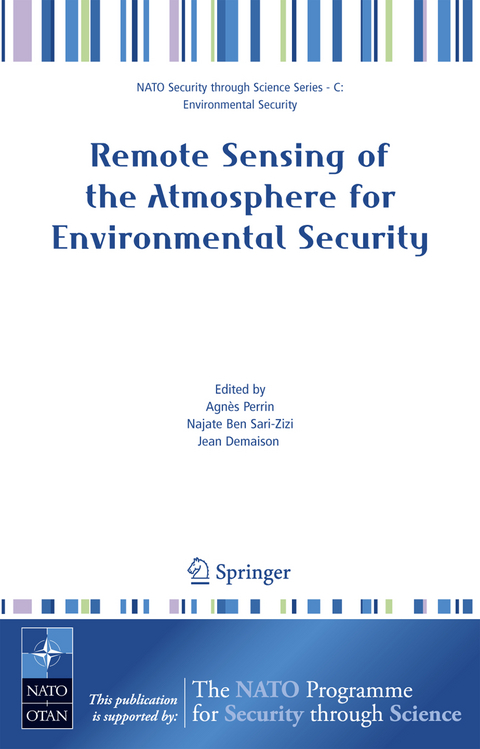
Remote Sensing of the Atmosphere for Environmental Security
Springer-Verlag New York Inc.
978-1-4020-5089-3 (ISBN)
Recent ecological disasters make human beings aware of changes in the Earth’s climate. At the present time anthropogenic activities lead to the emission of greenhouse gases, pollutants, aerosols and ozone depleting substances and the scientific community in general feels responsible for understanding how changes in atmospheric chemistry can affect the Earth’s climate.
The first part of these proceedings describes the current capabilities of various satellite experiments which are performing measurements of the Earth’s atmosphere, as for example some of the results obtained recently by three experiments onboard the Environment Satellite (ENVISAT), namely, the Global Ozone Monitoring Experiment (GOME), the SCanning Imaging Absorption for Atmospheric CHartographY (SCIAMACHY) and the Michelson Interferometer for Passive Atmospheric Sounding (MIPAS). For the analysis of spectra recorded by these instruments it is necessary to make good use of efficient radiative transfer codes. These computer codes need as input, a dataset of high quality spectroscopic parameters which can be generated only through a careful analysis of high quality laboratory measurements. In addition some of the future satellite missions which are under preparation at the European Space Agency (ESA) are briefly described.
Spectroscopic Measurements of Tropospheric Composition from Satellite Measurements in the Ultraviolet and Visible: Steps Toward Continuous Pollution Monitoring from Space.- ESA Spectroscopy Studies in Support of Spaceborne Atmospheric Composition Sounding.- The MIPAS Experiment Aboard ENVISAT: Remote Sensing of Atmospheric Composition.- Performances of the Operational Retrieval Code for MIPAS on Envisat and Possible Improvements of Retrieval Techniques for Environment and Climate.- New Measurements of Trace Species in the Upper Troposphere from Infra-Red Spectra of the Atmosphere.- Remote Sensing of the Non-LTE Atmosphere.- Quantitative Spectroscopy and Atmospheric Measurements.- Quantitative Laboratory Spectroscopy of Atmospheric Trace Gases.- Global Modeling of High-Resolution Spectra of Linear Molecules CO2, N2O and C2H2.- CDSD-296, The High-Precision Carbon Dioxide Spectroscopic Databank: Version for Atmospheric Applications.- Theoretical Quantitative Spectroscopy: Computer Simulation of Molecular Spectra.- Recent Results on Infrared Molecular Line Broadening and Shift Parameters.- Half-Widths and Line Shifts of Water Vapor for Atmospheric Applications: Measurement and Theory.- Quantitative Rotational Spectroscopy for Atmospheric Research.- Pressure-Broadening of the 22.2 GHz Line of Water: Basic Results for Remote Sensing of the Atmosphere.- Rotational Spectroscopy at the Jet Propulsion Laboratory.- Correlation Between Precipitable Water and Rainfall Using Global Positioning System (GPS) Technique.- Extreme Variability of Aerosol Optical Properties: The Cairo Aerosol Characterization Experiment Case Study.- Urban Air Pollution and Its Photochemistry Studied by Laser Spectroscopic Methods.- The Atmospheric Chemistry Ether Group: Expertise and Database.- An Integrated Approach to Study the Chemistry-Climate Interactions in the Atmosphere.
| Erscheint lt. Verlag | 22.8.2006 |
|---|---|
| Reihe/Serie | Nato Security through Science Series C: |
| Zusatzinfo | XI, 353 p. |
| Verlagsort | New York, NY |
| Sprache | englisch |
| Maße | 210 x 297 mm |
| Themenwelt | Sachbuch/Ratgeber ► Natur / Technik ► Natur / Ökologie |
| Naturwissenschaften ► Biologie ► Biochemie | |
| Naturwissenschaften ► Biologie ► Ökologie / Naturschutz | |
| Naturwissenschaften ► Geowissenschaften ► Geografie / Kartografie | |
| Naturwissenschaften ► Geowissenschaften ► Geologie | |
| Naturwissenschaften ► Geowissenschaften ► Meteorologie / Klimatologie | |
| Technik ► Umwelttechnik / Biotechnologie | |
| ISBN-10 | 1-4020-5089-5 / 1402050895 |
| ISBN-13 | 978-1-4020-5089-3 / 9781402050893 |
| Zustand | Neuware |
| Haben Sie eine Frage zum Produkt? |
aus dem Bereich


